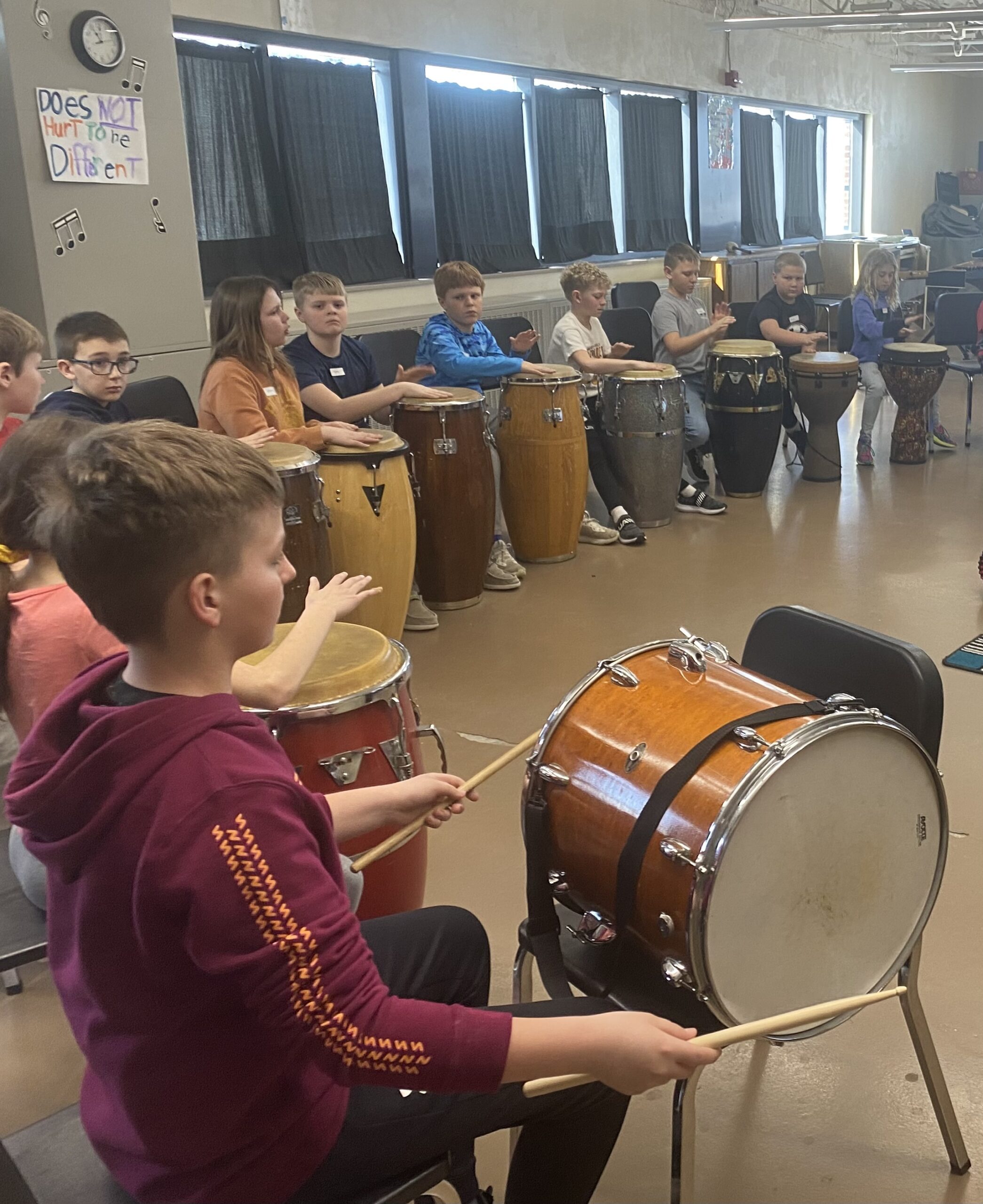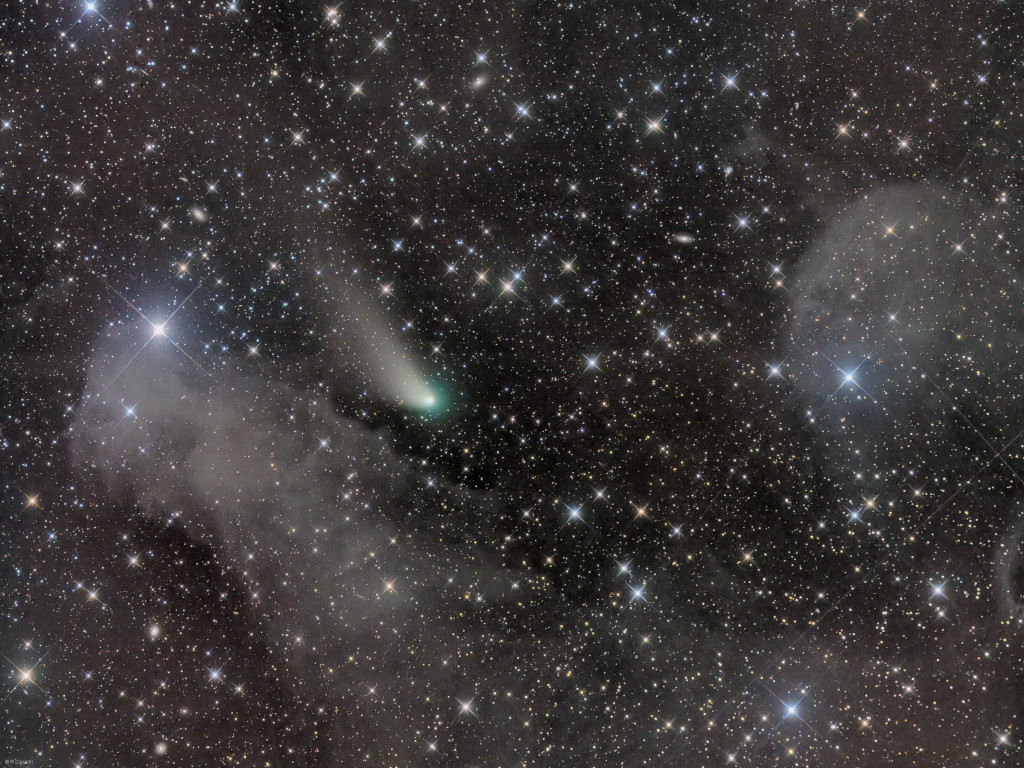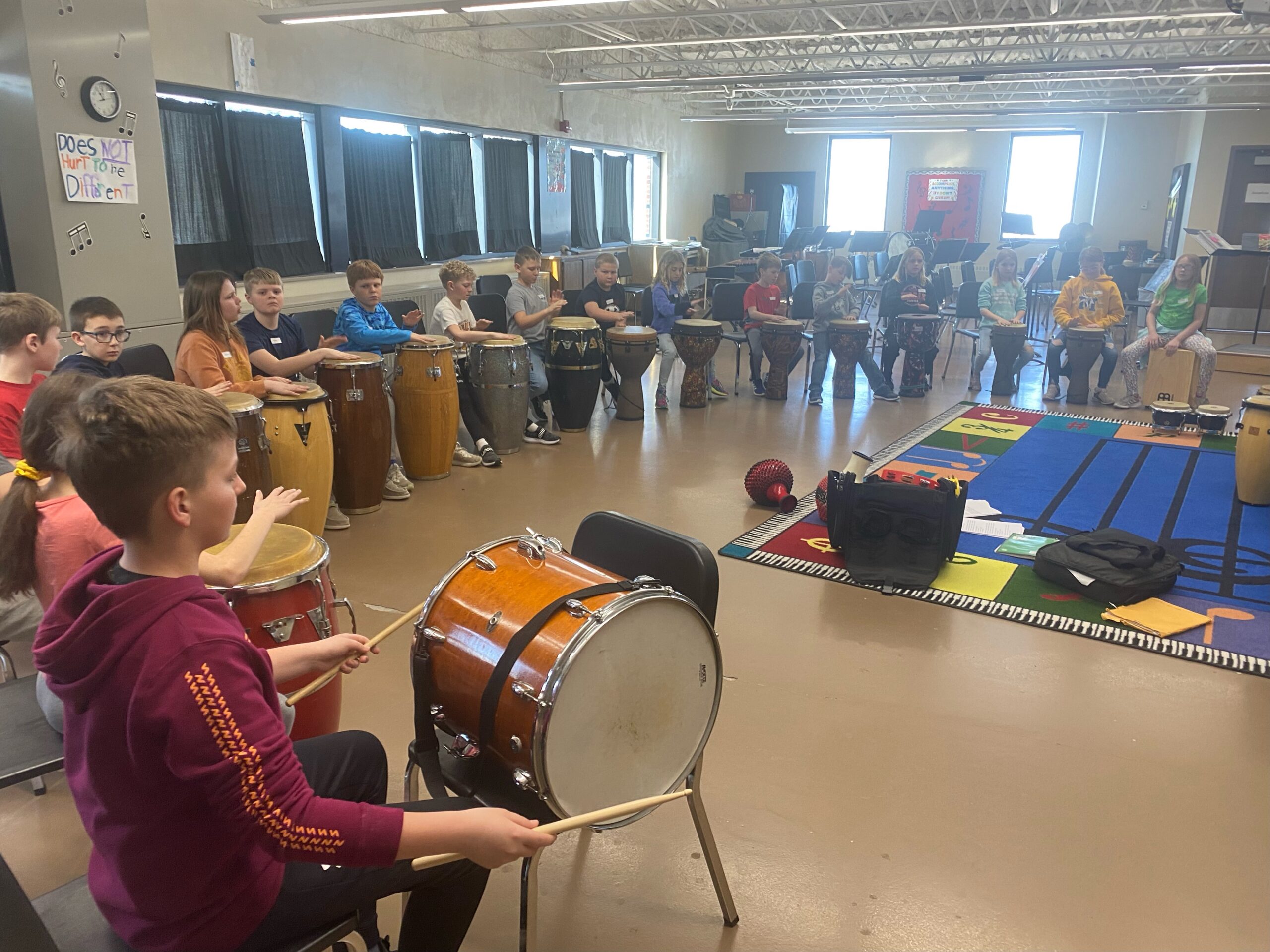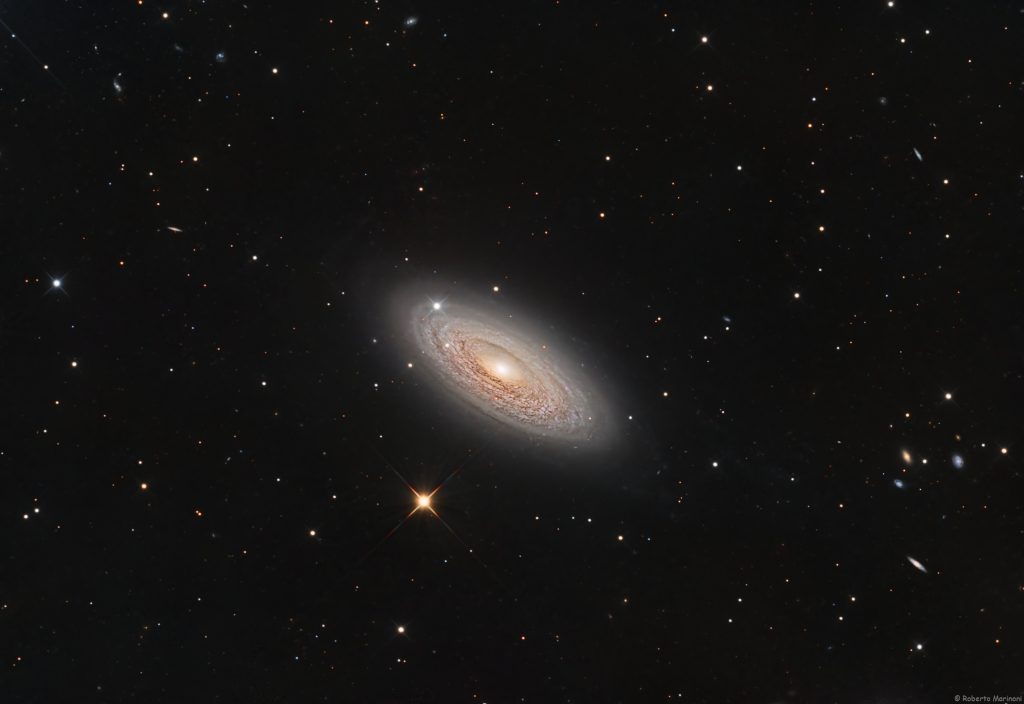Blog
Rosette Nebula ( NGC2237 ) Colors processed with the Hubble SHO palette. The synthetic color image is a SHO palette modified through the Ha, SII and OIII data. The chromatic contrast of the three emission lines in this SHO version shows us how different components are combined and mixed.
The Rosette Nebula, also known as Caldwell 49, is a large, circular HII region. It lies at the edge of a huge molecular cloud in the constellation Monoceros. The open cluster NGC 2244 (which can be seen at the center of the nebula) is associated with the nebula, as this star cluster has formed through the nebula’s matter. The nebula and cluster are 5,200 light-years from Earth and the size of the nebula is estimated to be around 130 light-years in diameter. The radiation from the young stars excites the atoms in the nebula, causing them to emit radiation that makes the nebula glow. It is believed that the stellar wind from stars O and B exerts pressure on the entire cloud, causing its compression and the formation of stars in the nebula.
The Rosette Nebula complex is described through several objects in the NGC catalog: NGC 2237 (part of the nebula and is also used to describe the entire nebula), NGC 2244 (open cluster in the center detailed above), NGC 2238 (part of the nebula), NGC 2239 (part of the nebula) and NGC 2246 (part of the nebula).

Sir Elton Hercules John CH CBE (born Reginald Kenneth Dwight; 25 March 1947) is a British singer, pianist and composer. Collaborating with lyricist Bernie Taupin since 1967, John has sold over 300 million records worldwide, making him one of the best-selling artists of all time. He is the most successful solo artist in the history of the US Billboard charts. Acclaimed by critics and musicians, particularly for his work during the 1970s and for his lasting impact on the music industry, his music and showmanship have had a significant impact on popular music. His songwriting partnership with Taupin is one of the most successful in history. John has more than fifty Top 40 hits in the UK Singles Chart and US Billboard Hot 100, including nine number ones in the UK and US, as well as seven consecutive number-one albums in the US. His tribute single to Princess Diana, “Candle in the Wind 1997“, a rewritten version of his 1974 single, sold over 33 million copies worldwide and is the best-selling chart single of all time.In 2021, he became the first solo artist with UK Top 10 singles across six decades.
more...Aretha Louise Franklin March 25, 1942 – August 16, 2018) was an American singer, songwriter and pianist. Referred to as the “Queen of Soul“, she has twice been placed ninth in Rolling Stone‘s “100 Greatest Artists of All Time”. With global sales of over 75 million records, Franklin is one of the world’s best-selling music artists.
As a child, Franklin was noticed for her gospel singing at New Bethel Baptist Church in Detroit, Michigan, where her father C. L. Franklin was a minister. At the age of 18, she was signed as a recording artist for Columbia Records. While her career did not immediately flourish, Franklin found acclaim and commercial success once she signed with Atlantic Records in 1966. Hit songs such as “I Never Loved a Man (The Way I Love You)“, “Respect“, “(You Make Me Feel Like) A Natural Woman“, “Chain of Fools“, “Think“, and “I Say a Little Prayer“, propelled Franklin past her musical peers.
Franklin continued to record acclaimed albums such as I Never Loved a Man the Way I Love You (1967), Lady Soul (1968), Spirit in the Dark (1970), Young, Gifted and Black (1972), Amazing Grace (1972), and Sparkle (1976), before experiencing problems with the record company. Franklin left Atlantic in 1979 and signed with Arista Records. The singer appeared in the 1980 film The Blues Brothers before releasing the successful albums Jump to It (1982), Who’s Zoomin’ Who? (1985) and Aretha (1986) on the Arista label. In 1998, Franklin returned to the Top 40 with the Lauryn Hill-produced song “A Rose Is Still a Rose“; later, she released an album with the same name.
more...Stephen Paul Motian (March 25, 1931 – November 22, 2011) was an American jazz drummer, percussionist, and composer. Motian played an important role in freeing jazz drummers from strict time-keeping duties.
He first came to prominence in the late 1950s in the piano trio of Bill Evans, and later was a regular in pianist Keith Jarrett‘s band for about a decade (c. 1967–1976). Motian began his career as a bandleader in the early 1970s. Perhaps his two most notable groups were a longstanding trio of guitarist Bill Frisell and saxophonist Joe Lovano, and the Electric Bebop Band where he worked mostly with younger musicians on interpretations of bebop standards.
Motian was born in Philadelphia, Pennsylvania, and raised in Providence, Rhode Island. He was of Armeniandescent. After playing guitar in his childhood, Motian began playing the drums at age 12, eventually touring New England in a swing band. During the Korean War he joined the Navy.
Motian became a professional musician in 1954, and briefly played with pianist Thelonious Monk. He became well known as the drummer in pianist Bill Evans‘s trio (1959–64), initially alongside bassist Scott LaFaro and later with Chuck Israels.
more...Cecil Percival Taylor (March 25, 1929 – April 5, 2018) was an American pianist and poet.
Taylor was classically trained and was one of the pioneers of free jazz. His music is characterized by an energetic, physical approach, resulting in complex improvisation often involving tone clusters and intricate polyrhythms. His technique has been compared to percussion. Referring to the number of keys on a standard piano, Val Wilmer used the phrase “eighty-eight tuned drums” to describe Taylor’s style. He has been referred to as being “like Art Tatum with contemporary-classical leanings”.
Cecil Percival Taylor was born on March 25, 1929, in Long Island City, Queens, and raised in Corona, Queens. As an only child to a middle-class family, Taylor’s mother encouraged him to play music at an early age. He began playing piano at age six and went on to study at the New York College of Music and New England Conservatory in Boston. At the New England Conservatory, Taylor majored in composition and arranging. During his time there, he also became familiar with contemporary European art music. Bela Bartókand Karlheinz Stockhausen notably influenced his music.
more...Béla Viktor János Bartók ; 25 March 1881 – 26 September 1945) was a Hungarian composer, pianist, and ethnomusicologist. He is considered one of the most important composers of the 20th century; he and Franz Liszt are regarded as Hungary’s greatest composers. Through his collection and analytical study of folk music, he was one of the founders of comparative musicology, which later became ethnomusicology.
more...
The final Rhythm Roots Workshop Residency at Lincoln Elementary in Ivanhoe, MN; down the street from South Dakota. Today is Performance Day and a culmination of the 5 day residency. K-6th grades will perform at 2pm for the community. Their percussion ensembles are called Color Crew, The Rebels, Peanut Butter Band and Do It Perfect. Combining rhythms of Egypt, Algeria, Morocco, Spain, Haiti, Cuba, Trinidad, Dominican Republic, Bulgaria and songs from South Africa, Liberia, Senegal and Nigeria.



more...
Comet C/2022E3 (ZTF) has faded. During its closest approach to our fair planet in early February Comet ZTF was a mere 2.3 light-minutes distant. Then known as the green comet, this visitor from the remote Oort Cloud is now nearly 13.3 light-minutes away. In this deep image, composed of exposures captured on March 21, the comet still sports a broad, whitish dust tail and greenish tinted coma though. Not far on the sky from Orion’s bright star Rigel, Comet ZTF shares the field of view with faint, dusty nebulae and distant background galaxies. The telephoto frame is crowded with Milky Way stars toward the constellation Eridanus. The influence of Jupiter’s gravity on the comet’s orbit as ZTF headed for the inner solar system, may have set the comet on an outbound journey, never to return.

The core of the Tangos is the letra, three or four octosyllabic lines. As with the Bulerías, the the first line is often repeated, and the repeated lines are balanced by a longer consequent phrase.
Before a letra a Tangos may open with a guitar falseta or an estribillo, in which the singer sings a traditional melody with nonsense syllables (“le le le, ni, ni, etc.). The estribillo may return throughout the piece as a chorus after a letra.
Once the letra begins it can be broken up several times with remates performed by the dancer. This usually occurs between the first and second line of the letra, and often occurs more frequently, giving the dance a improvisatory air.
Thus, the letras themselves can be further broken up with remates or escobillas from the dancer or with guitar falsetas. A dancer may also choose to perform a long footwork passage accompanied by compás patterns from the guitarist and palmista (an escobilla performed “a palo seco” or dry, without guitar accompaniment).
As in Bulerías, Tangos can end with a cierre – a closing pattern – that is based on a different set of chords than the letras. The dancer can also perform a cue (llamada) that leads into a traveling exit – a salida.
It’s also common to end certain forms in flamenco with a macho, a transition into a faster, related form. Tangos wiil often end with a brief Rumba Flamenca. Similarly, Tientos will often end with a brief Tangos.
more...Lee Oskar (born 24 March 1948) is a Danish harmonica player, notable for his contributions to the sound of the rock-funk fusion group War, which was formed by Howard E. Scott and Harold Brown, his solo work, and as a harmonica manufacturer. He continues to play with 3 other original War band members, Harold Brown, Howard Scott and B.B. Dickerson, under the name LowRider Band.
Born in Copenhagen, Denmark in 1948, Oskar was six years old when a family friend gave him his first harmonica. “I came from an area where every kid on the block had a harmonica”, he remembers. He grew up listening to Danish radio, enjoying all types of music and cites Ray Charles as the biggest influence from that period. When he was 17, Oskar decided that the United States was where a harmonica player should make his career. So he moved to New York at the age of 18 with little more than a harmonica in his pocket. With no money, Oskar played harmonica in the streets of New York. Eventually arriving in Los Angeles, via Toronto and San Francisco, Oskar soon met and joined forces with Eric Burdon who had recently disbanded The Animals and was searching for new collaborators.
more...Steve Kuhn (born March 24, 1938) is an American jazz pianist, composer, arranger, bandleader, and educator.
Kuhn was born in New York City, New York, to Carl and Stella Kuhn (née Kaufman), and was raised in Newton, Massachusetts. His parents were Hungarian-Jewish immigrants. At the age of five, he began studying piano under Boston piano teacher Margaret Chaloff, mother of jazz baritone saxophonist Serge Chaloff, who taught him the “Russian style” of piano playing. At an early age he began improvising classical music. As a teenager, he appeared in jazz clubs in the Boston area with Chet Baker, Coleman Hawkins, Vic Dickenson, and Serge Chaloff.
After graduating from Harvard, he attended the Lenox School of Music where he was associated with Ornette Coleman, Don Cherry, and Gary McFarland. The school’s faculty included Bill Evans, George Russell, Gunther Schuller, and the members of the Modern Jazz Quartet. This allowed Kuhn to play, study, and create with some of the most forward-thinking innovators of jazz improvisation and composition; it culminated with his joining trumpeter Kenny Dorham‘s group for an extended time and (briefly) John Coltrane‘s quartet at New York’s Jazz Gallery club.
more...Boogie Bill Webb (March 24, 1924 – August 22, 1990) was an American Louisiana blues and rhythm-and-blues guitarist, singer and songwriter. His music combined Mississippi country blues with New Orleans R&B. His best-known recordings are “Bad Dog” and “Drinkin’ and Stinkin'”. Despite a lengthy (albeit intermittent) career, Webb released only one album.
Webb was born in Jackson, Mississippi. His got his first guitar at the age of eight, made from a cigar box and strung with screen wire. His greatest influence was Tommy Johnson. With a real guitar obtained when he was a teenager, he won a talent show in 1947. He subsequently appeared briefly in the musical film The Jackson Jive. He moved to New Orleans in 1952.
more...The 4th day of a Rhythm Roots Workshop Residency at Lincoln Elementary in Ivanhoe, MN on the South Dakota boarder. Mounting performances for our exciting concert tomorrow at 2pm. K thru 6th grades will perform rhythms from around the world and sing and chant a Celebration of Diversity.

A mere 46 million light-years distant, spiral galaxy NGC 2841 can be found in planet Earth’s night sky toward the northern constellation of Ursa Major. This sharp image centered on the gorgeous island universe also captures spiky foreground Milky Way stars and more distant background galaxies within the same telescopic field of view. It shows off the bright nucleus of NGC 2841, along with its inclined galactic disk, and faint outer regions. Dust lanes, small star-forming regions, and young star clusters are embedded in the galaxy’s patchy, tightly wound spiral arms. In contrast, many other spirals exhibit broader, sweeping arms with large star-forming regions. NGC 2841 has a diameter of over 150,000 light-years, making it even larger than our own Milky Way. X-ray images suggest that extreme outflows from giant stars and stellar explosions create plumes of hot gas extending into a halo around NGC 2841.

Yvette Marie Stevens (born March 23, 1953), better known by her stage name Chaka Khan is an American singer. Her career has spanned more than five decades, beginning in the 1970s as the lead vocalist of the funk band Rufus. Known as the “Queen of Funk“, Khan was the first R&Bartist to have a crossover hit featuring a rapper, with “I Feel for You” in 1984. Khan has won ten Grammy Awards and has sold an estimated 70 million records worldwide.
With Rufus, she achieved four gold singles, four gold albums, and two platinum albums. In the course of her solo career, Khan achieved three gold singles, three gold albums, and one platinum album with I Feel for You. She has collaborated with Steve Winwood, Ry Cooder, Robert Palmer, Ray Charles, Quincy Jones, Guru, Chicago, De La Soul, Mary J. Blige, among others. In December 2016, Billboard magazine ranked her as the 65th most successful dance club artist of all time. She was ranked at No. 17 in VH1‘s original list of the 100 Greatest Women of Rock & Roll. Khan has been nominated for induction into the Rock and Roll Hall of Fame three times as a solo artist and four times as a member of Rufus featuring Chaka Khan; the first time in 2012 as a member of Rufus.
Yvette Marie Stevens was born on March 23, 1953, into an artistic, bohemian household in Chicago, Illinois. The eldest of five children born to Charles Stevens and Sandra Coleman, she has described her father as a beatnik and her mother as “able to do anything”. She was raised in the Hyde Park area, “an island in the middle of the madness” of Chicago’s rough South Side housing projects. Her sister Yvonne later became a successful musician in her own right, under the name Taka Boom. Her only brother, Mark, who formed the funk group Jamaica Boys and was a member of Aurra, also became a successful musician. She has two other sisters, Zaheva Stevens and Tammy McCrary.
more...More Posts
- Wilbur Ware Day
- World Music with Tsedenia Gebremarkos
- Daily Roots with the Impact All Stars
- The Cosmos with NGC 2080
- Buddy Holly Day
- Little Milton Day
- Sonny Rollins Day
- World Music with Paco de Lucia
- Daily Roots with David Madden and Augustus Pablo
- The Cosmos with NGC 6960
- Charles Moffett
- Jimmy Reed Day
- World Music with Shashmaqam
- Daily Roots with Junior Brown
- The Cosmos with NGC 3628
- Buddy Miles Day
- John Cage Day
- Sunnyland Slim Day
- World Music with Maayan Band
- Daily Roots with Jerry Harris